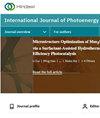彩色太阳能电池的光谱因子:罗马尼亚主要城市地区的案例研究
IF 2.1
4区 工程技术
Q3 CHEMISTRY, PHYSICAL
引用次数: 0
摘要
用于建筑集成光伏(BIPV)应用的光伏组件由不同颜色制成,旨在提高建筑的视觉美感。但是,施加到基本PV模块的表面上的彩色涂层本质上与转换效率的降低有关。从不同的角度来看,光伏组件的效率是在行业标准测试条件(STC)下评估的。由于光谱失配,在室外条件下运行的PV模块的效率可能与STC评估的标准值显著不同。在本研究中,利用光谱因子(SF)评估了光谱太阳辐照度分布对彩色光伏组件效率的影响。SF量化了由STC的频谱差异引起的相对功率增益或损耗。通过对罗马尼亚四个主要城市地区的案例研究,说明了这一理论。根据气溶胶机器人网络(AERONET)检索的大气参数,使用简单的勒克纳光谱太阳辐照度模型估计实际的太阳辐射光谱。研究结果强调,BIPV的美观性需要高能源成本:根据颜色的不同,在结晶硅光伏组件表面涂覆涂层可能会使其转换效率降低一半。本文章由计算机程序翻译,如有差异,请以英文原文为准。
Spectral Factor of Colored Solar Cells: A Case Study on the Main Urban Areas in Romania
PV modules for Building-Integrated Photovoltaic (BIPV) applications are made of different colors aimed at raising the visual aesthetic of the building. But a colored coating applied to the surface of a basic PV module is inherently associated to a decrease in conversion efficiency. From a different perspective, the efficiency of a PV module is evaluated under the industry standard test conditions (STC). Due to spectral mismatch, the efficiency of a PV module operating in outdoor conditions may substantially differ from the standard value evaluated at STC. In this study, the influence of spectral solar irradiance distribution on the colored PV module efficiency is evaluated in terms of spectral factor (SF). SF quantifies the relative power gain or loss caused by the spectral difference from STC. The theory is illustrated with a case study on the main four urban areas in Romania. The actual solar radiation spectrum is estimated with the simple Leckner spectral solar irradiance model, based on atmospheric parameters retrieved from the Aerosol Robotic Network (AERONET). The results emphasize that the aesthetic of BIPV comes at a high energy cost: depending on the color, a coating applied on the surface of a crystalline silicon PV module may reduce its conversion efficiency even by half.
求助全文
通过发布文献求助,成功后即可免费获取论文全文。
去求助
来源期刊
CiteScore
6.00
自引率
3.10%
发文量
128
审稿时长
3.6 months
期刊介绍:
International Journal of Photoenergy is a peer-reviewed, open access journal that publishes original research articles as well as review articles in all areas of photoenergy. The journal consolidates research activities in photochemistry and solar energy utilization into a single and unique forum for discussing and sharing knowledge.
The journal covers the following topics and applications:
- Photocatalysis
- Photostability and Toxicity of Drugs and UV-Photoprotection
- Solar Energy
- Artificial Light Harvesting Systems
- Photomedicine
- Photo Nanosystems
- Nano Tools for Solar Energy and Photochemistry
- Solar Chemistry
- Photochromism
- Organic Light-Emitting Diodes
- PV Systems
- Nano Structured Solar Cells

 求助内容:
求助内容: 应助结果提醒方式:
应助结果提醒方式:


